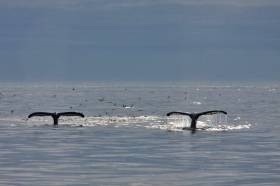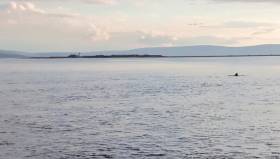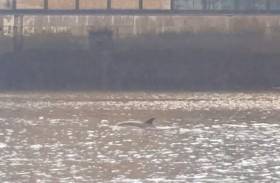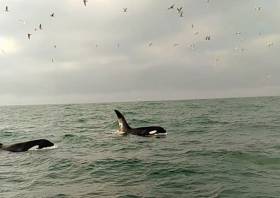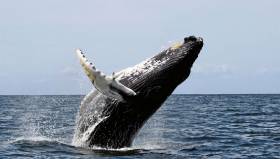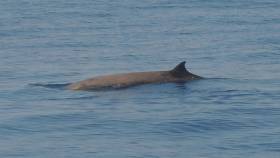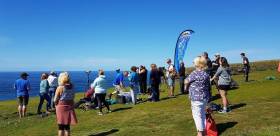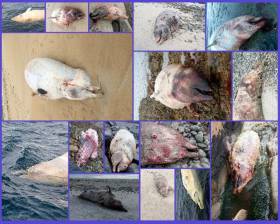Displaying items by tag: IWDG
Whale & Dolphin Strandings In Cork This Week ‘Only A Percentage Of What Is Actually Dead At Sea’
#MarineWildlife - Unusual weather for this time of year may be responsible for a recent spate of whale and dolphin strandings on the Cork coast in the past week.
The Irish Examiner reports that among the eight strandings were the carcass of a sperm whale on Long Strand in West Cork and a dolphin with fishing line around its beak in Schull.
However, the Irish Whale and Dolphin Group’s (IWDG) Mick O’Connell said that while the statistic was high within such a short timeframe, it was not necessarily a mystery.
“We normally get the same thing every year,” said the IWDG stranding officer. “It is usually more in the southwest and west, but this year, I suppose we have had more southeast winds, which probably explains it.”
O’Connell added that the strandings are “only a percentage of what is actually dead at sea” — and that post-mortems may “shed some light in their deaths”.
The Irish Examiner has more on the story HERE.
Irish Whale & Dolphin Group Continues Its ‘Trail Of The Whale’ Library Tour Across The Country
The Irish Whale and Dolphin Group (IWDG) is bringing stories from the Celtic Mist’s historic marine wildlife survey voyage around Iceland to libraries and other venues nationwide.
Already the IWDG has visited 10 venues across eight counties in its ‘On the Trail of the Whale’ tour, which continues tonight (Tuesday 19 February) at 7pm in Killarney Library.
In May last year a crew of marine scientists and enthusiasts set sail on the IWDG’s research yacht for a weeks-long return passage to the edge of the Arctic Circle in search of humpback whales, building “strong links with Iceland and its people” along the way.
Last month, IWDG members began sharing their experiences from the rewarding mission in images, stories and video of the voyage to audiences in libraries and other venues across the island of Ireland — beginning on 14 January at DLR LexIcon and since visiting Galway, Tralee, Monaghan town and Arklow, as well as Bangor and Warrenpoint in Northern Ireland and Dublin’s Poolbeg Yacht Club.
“Through the tour, we want to encourage people to get involved,” IWDG’s chief science officer Dr Simon Berrow told the Irish Examiner. “If even one person at every event we do gets interested [in marine life] and gets motivated, that’s fantastic.”
The Irish Examiner has much more on the story HERE.
Galway’s Dolphin Nimmo Returns To City Waters
#MarineWildlife - Galway residents have a great opportunity to see a wild dolphin close to the city centre with the return of regular visitor to the Nimmo’s Pier area this week.
Nicknamed Nimmo, the solitary bottlenose dolphin was first sighted in the city in April 2015 and since then has become an annual fixture, appearing and staying longer each time.
The Irish Whale and Dolphin Group (IWDG) suggests this is a sign that the area around Galway city is now a “more important core feeding habitat for Nimmo”.
In other news, the IWDG’s research vessel Celtic Mist will embark on a series of week-long surveys this summer in search of humpback whales.
IWDG members are invited to join any of the nine legs, the first of which sets sail from 9-15 June (weather permitting) between Cork and Dingle/Fenit.
For details on how to book a place on any of these voyages and for further information, contact [email protected].
Large Carcass Spotted In Celtic Sea Area Popular With Fin Whales
#MarineWildlife - Naval Service personnel on patrol with the LÉ Samuel Beckett encountered the carcass of a large whale some 50 nautical miles south-east of Ballycotton Lighthouse in the days after Christmas.
The “mystery whale” is neither a sighting (which only counts or living cetaceans) nor a stranding. But as the Irish Whale and Dolphin Group (IWDG) says, the encounter “serves to remind us that the animals that wash up on our shoreline may represent only a small percentage of the total number of cetaceans that expire at sea of presumably natural causes.”
IWDG sightings officer Pádraig Whooley said the location of these whale remains was “interesting as this area of the Celtic Sea has produced the most consistent large-whale sightings in recent months, with fairly regular sightings of fin whales from land-based sites between Ram Head, Ardmore extending east towards the Hook Head lighthouse.”
Common Dolphin In River Liffey Brightens A Dreary Day For Dubliners
A dreary, stormy day in Dublin city centre was brightened with the appearance of a common dolphin swimming up the River Liffey as far as the Loopline Bridge.
The Irish Whale and Dolphin Group (IWDG) says it got its first reports early this morning (Wednesday 28 November) from the Jeanie Johnston, whose John O’Neill shot this video of the solo cetacean swimming loops in the river.
It was spotted swimming strongly as far west as Liberty Hall around lunchtime before heading back east and towards Dublin Bay.
Dolphins are known to develop kidney and skin problems on prolonged exposure to freshwater environments such as rivers.
However, the IWDG moved to assuage public concerns over this particular animal — saying that if it was swimming as strongly as sightings suggested, it would be more than able to swim back to sea.
It’s suggested that this short-beaked visitor may be one of a pod of some 20 dolphins known to be feeding off the East Coast this month.
Killer Whales Spotted Off Dublin Coast May be Same That Visited Blasket Islands Earlier This Year
#MarineWildlife - Video posted on social media over the weekend of two killer whales spotted off the Co Dublin coast has gone viral.
Trawlerman James Mac Cluskey used his phone to record a few seconds’ glimpse of the pair of male orcas, which came close to his boat some 8km off Rockabill on Saturday afternoon (17 November).
According to the Irish Whale and Dolphin Group (IWDG), it’s the second sighting of the largest species in the dolphin family off the East Coast in recent weeks, with another fisherman reporting an encounter some 22km off Skerries on 30 October.
And it’s believed the duo may be part of the Scottish West Coast Community Group, a unique orca pod long under threat of extinction owning to not having produced any calves for years.
Earlier this year, whales from this group were identified feeding off the Blasket Islands in Co Kerry, showing just how far their range extends.
Irish Whale & Dolphin Sightings Data Now Back Online
#MarineWildlife - The Irish Whale and Dolphin Group’s (IWDG) datasets for cetacean sightings and strandings around the Irish coast are now back online after previous versions were corrupted in a cyber attack.
The launch coincided with the hosting in Kilkenny last week of the 25th meeting of the Global Biodiversity Information Facility (GBIF), an international network aimed at providing open access to data about life on Earth, marine wildlife included.
Twelve months of sighting and stranding data — including the recent ‘unusual mortality event’ of Cuvier’s beaked whales — can now be accessed, searchable by species, recorder, date and location, and all sightings are mappable.
Longer-term data is also available on request, for example for undergrad or postgraduate student projects.
All information in these datasets is provided by the IWDG’s loose network of volunteers around the island of Ireland, and is hailed by the group’s chief Dr Simon Berrow as “an excellent example of what can be achieved through citizen science.”
Dr Berrow adds: “Our recording schemes receive very little funding support. The sighting scheme gets no funding and currently the stranding scheme receives grant support of €10,000 from the NPWS, but it is not guaranteed and depends on other NPWS funding obligations.
“IWDG are committed to maintaining these recording schemes in the long term, as its only with time that we can identify trends; whether they are new threats to whale and dolphin populations or changing distributions driven by climate change and other large scale events.”
Both recording schemes have been run and supported by Pádraig Whooley and Mick O'Connell on behalf of the IWDG for over 20 years, and Dr Berrow says the information collected comprises “some of the most robust data in Europe to address key environmental issues and meet legal obligations.
“None of this would be possible without the IWDG members and non-members who go to great lengths to report strandings and sightings and take our calls to head out to the beaches and headlands all around Ireland to collect another data point. To them we offer our respect and thanks.”
Among the more recent sightings you’re likely to find is Boomerang, the humpback whale with the distinctive dorsal fin who’s made Ireland a regular stop since 2001.
He was spotted off the Clare and Kerry coast last month, as the Irish Mirror reports — and his return is a good omen for the quality of the ocean around Ireland, Dr Berrow suggests.
State To Assist In Beaked Whale Deaths Investigation
#MarineWildlife - The Department of Foreign Affairs will assist with an investigation into the extraordinary numbers of Cuvier’s beaked whale deaths in Irish waters over recent weeks.
Tánaiste and Foreign Affairs Minister Simon Coveney has “instructed his department, in consultation with the National Parks and Wildlife Service, to initiate discussions regarding these about large number of stranded Cuvier's beaked whales with the UK authorities,” according to the Irish Whale and Dolphin Group.
As previously reported on Afloat.ie, the IWDG had expressed concern over the large numbers of dead beaked whales washed up on Ireland’s North West coast last month.
The total of whale strandings since the beginning of August has now risen to 58 across Ireland and Scotland, many of them Cuvier’s or True’s beaked whales, as BBC News reports.
Whale Watch Ireland 2018: The Results Are In
#MarineWildlife - The Papal visit brought numbers down for 2018’s Whale Watch Ireland last Saturday (25 August).
But some 950 wildlife enthusiasts still came out to 19 sites around the island of Ireland for the chance to spot some of the many whales, dolphins, porpoise and other wildlife in our waters.
Most sites reported a reduction in numbers, with only three seeing a modest increase. But it’s expected that next year’s turnout will be back to it regular size, coinciding as ever with events for Heritage Week.
Sightings were also lower this year — on average a 43% reduction on 2017’s records — with only three cetacean species spotted, namely harbour porpoise (50), common dolphins (40) and minke whales (5).
The success or otherwise of event is generally determined by the prevailing weather on the day, and thankfully most sites were treated to calm seas and clear skies which resulted in cetacean sightings at three-quarters of the sites covered at this year’s event.
Other species noted include grey seals, a basking shark and a sunfish.
Despite the lower attendance and sighting rates, the Irish Whale and Dolphin Group says it is “very pleased” with this year’s results.
“And we hope that among those who attended, there will be some new members for IWDG and dedicated whale watchers who are willing to volunteer some of their time and energy in furthering our understanding of the whales and dolphins that live in Irish coastal waters.”
The IWDG reports that usual there was a mix of both Irish and overseas visitors to the watches, and for many attending this was their first encounter with a cetacean in the wild in Irish waters.
Record Numbers Of Beaked Whale Deaths Cause Alarm
#MarineWildlife - The Irish Whale and Dolphin Group (IWDG) has expressed concern in the wake of at least 16 Cuvier’s beaked whales washing up on the Irish coast this month.
Following the discovery of five beaked whales in a single day at the start of August, the IWDG says a minimum of 16 — a new Irish record — were recorded along the North West coast from Galway to Donegal between 3 and 22 August.
“During the same period, at least 13 were found in Scotland and two in Iceland,” said IWDG strandings officer Mick O’Connell.
“Previous studies have suggested that only a small number of dead animals actually get washed ashore and recorded, so the number of dead animals may be significantly higher.”
While no cause of death has been established, due to the poor condition of the carcasses, it appears that the animals all died around the same time, which “makes causes such as disease, plastic ingestion etc seem unlikely as these would tend to be spread out over a longer time period and perhaps geographical range,” O’Connell said.
“The behaviour and distribution of this species makes large-scale fisheries interaction also seem unlikely.”
Sonar use has been suspected as a cause in previous similar strandings. “Mass strandings of beaked whales coincidental with naval exercises have been recorded in Greece, the Canaries and the Bahamas,” O’Connell said.
According to TheJournal.ie, the Royal Navy denies its use of sonar in training exercises causes any harm to marine wildlife.
The Naval Service in Ireland does not use sonar on its vessels.
In more positive marine mammal news, Nuala Moore writes for Independent.ie about her experiences swimming in Dingle harbour with its longtime resident dolphin Fungie.
The open sea swimming enthusiast made headlines earlier this year for becoming the first Irish woman to swim off Cape Horn.
But in Dingle, she’s just another acquaintance for Fungie in his daily adventures.



























